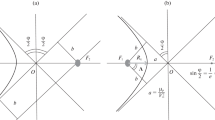Abstract
Methods for designing trajectories of spacecraft (SC) for missions that need to increase the inclination of their orbits to the ecliptic using energy-efficient gravity assist maneuvers (GAMs) around planets, their moons, and small Solar system bodies are developed. The focus is on the development of algorithms (taking into account accurate ephemerides) for designing chains of multiple GAMs that significantly raise the orbit of a SC above the plane of the ecliptic. Complete analytical formulas for the change of inclination as a result of a GAM in the general case of elliptic orbits of the SC and the partner planet are obtained.
Similar content being viewed by others
References
Yu. F. Golubev, A. V. Grushevskii, V. V. Koryanov, A. G. Tuchin, and D. A. Tuchin, “To the high inclined orbit formation with use of gravity assists maneuvers,” KIAM Preprint No. 64 (Keldysh Inst. Appl. Math., Moscow, 2015).
Yu. F. Golubev, A. V. Grushevskii, V. V. Koryanov, A. G. Tuchin, and D. A. Tuchin, “Orbit’s inclination change of celestial bodies in the Solar system with using gravity assists maneuvers,” KIAM Preprint No. 15 (Keldysh Inst. Appl. Math., Moscow, 2016).
Yu. F. Golubev, A. V. Grushevskii, V. V. Koryanov, A. G. Tuchin, and D. A. Tuchin, “The synthesis of gravity assist maneuvers sequence of the spacecraft to achieve high inclined orbits over ecliptic,” KIAM Preprint No. 43 (Keldysh Inst. Appl. Math., Moscow, 2016).
A. V. Labunsky, O. V. Papkov, and K. G. Sukhanov, Multiple Gravity Assist Interplanetary Trajectories, ESI Book Series (Gordon and Breach, London, 1998), pp. 9–266.
N. J. Strange, R. Russell, and B. Buffington, “Mapping the V-infinity globe,” in Proceedings of the AIAA/AAS Space Flight Mechanics Meeting, 2007, AAS Paper 07–277. http://russell.ae.utexas.edu/FinalPublications/ConferencePapers/07Aug_AAS-07-277.pdf.
B. Buffington, N. J. Strange, and S. Campagnola, “Global moon coverage via hyperbolic flybys,” in Proceedings of the 23rd International Symposium on Space Flight Dynamics, Pasadena, CA, 2012.
A. Wolf, “Touring the Saturnian system,” Space Sci. Rev. 104, 101–128 (2002).
Y. Kawakatsu, “V8 direction diagram and its application to swingby design,” in Proceedings of the 21st International Symposium on Space Flight Dynamics, Toulouse, France, 2009. http://issfd.org/ISSFD_2009/InterMissionDesignI/Kawakatsu.pdf.
J. M. S. Pérez, “Trajectory Design of Solar Orbiter,” in Proceedings of the 23rd International Symposium on Space Flight Dynamics, Pasadena, California, 2012. http://www.issfd.org/ISSFD_2012/ISSFD23_IMD1_3.pdf.
M. Konstantinov, V. Petukhov, and M. Thein, “Optimization spacecraft insertion into the system of heliocentric orbits for Sun exploration,” in Proceedings of the 65th International Astronautical Congress, Toronto, Canada, 2014, IAC-14-C1.9.4.
S. Campagnola and Y. Kawakatsu, “Jupiter magnetospheric orbiter: trajectory design in the Jovian system,” J. Spacecr. Rockets. 49, 318–324 (2012).
G. Janin, “Trajectory design for the Solar orbiter mission,” Monogr. Real Acad. Cien. Zaragoza, No. 25, 177–218 (2004). http://www.unavarra.es/vijtmc/Bertiz_Def/177Janin.pdf.
Spacecraft Navigation during Deep Space Research, Ed. by E. P. Molotov and A. G. Tuchin (Radiotekhnika, Moscow, 2016) [in Russian].
V. Sebekhei, Theory of Orbits: The Restricted Problem of Three Bodies (Nauka, Moscow, 1982) [in Russian].
Yu. F. Golubev, A. V. Grushevskii, V. V. Koryanov, A. G. Tuchin, and D. A. Tuchin, “Bifurcation points during gravity assist tours in the Jovian system,” Dokl. Phys. 60, 210 (2015).
Yu. F. Golubev, A. V. Grushevskii, V. V. Koryanov, and A. G. Tuchin, “Gravity assist maneuvers of a spacecraft in Jupiter system,” J. Comput. Syst. Sci. Int. 53, 445 (2014).
Yu. F. Golubev, A. V. Grushevskii, V. V. Koryanov, A. G. Tuchin, and D. A. Tuchin, “Low-cost flights in the Jovian system using tisserand coordinates,” J. Comput. Syst. Sci. Int. 54, 808 (2015).
A. V. Grushevskii, Yu. F. Golubev, V. V. Koryanov, and A. G. Tuchin, “Adaptive low radiation multibody gravity assist tours design in Jovian system for the landing on Jovian’s moons,” in Proceedings of the 65th International Astronautical Congress IAC 2014, Toronto, Canada, 2014, Manuscript IAC-14, C1,9,13.
L. F. Tóth, Dispositions on the Plane, Sphere and in Space (Fizmatgiz, Moscow, 1958) [in Russian].
Author information
Authors and Affiliations
Corresponding author
Additional information
Original Russian Text © Yu.F. Golubev, A.V. Grushevskii, V.V. Koryanov, A.G. Tuchin, D.A. Tuchin, 2017, published in Izvestiya Akademii Nauk, Teoriya i Sistemy Upravleniya, 2017, No. 2, pp. 108–132.
Rights and permissions
About this article
Cite this article
Golubev, Y.F., Grushevskii, A.V., Koryanov, V.V. et al. Formation of high inclined orbits to the ecliptic by multiple gravity assist maneuvers. J. Comput. Syst. Sci. Int. 56, 275–299 (2017). https://doi.org/10.1134/S1064230717020083
Received:
Revised:
Published:
Issue Date:
DOI: https://doi.org/10.1134/S1064230717020083



